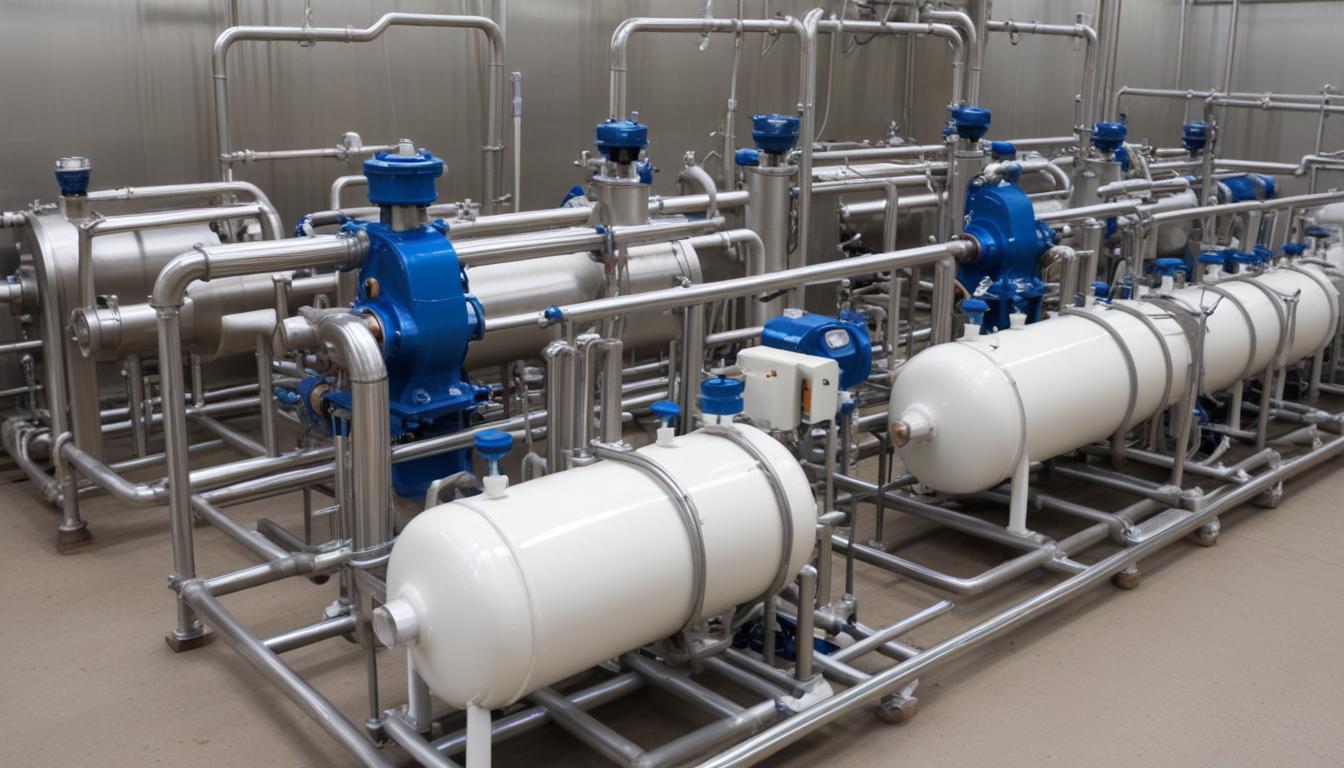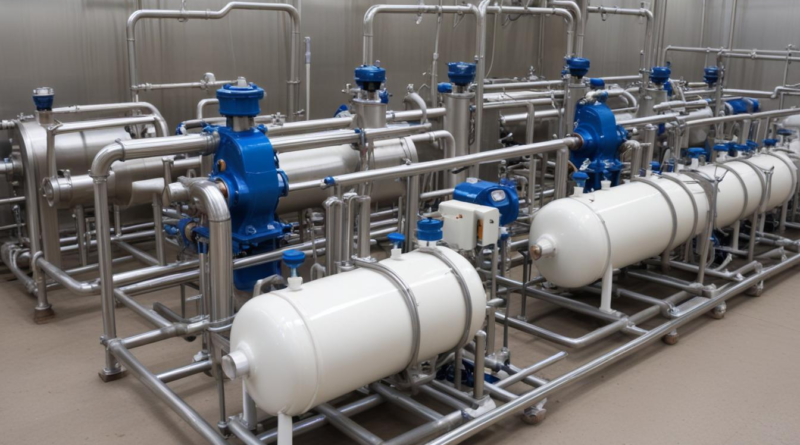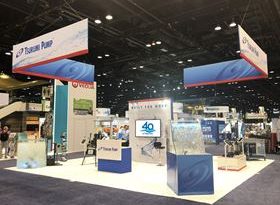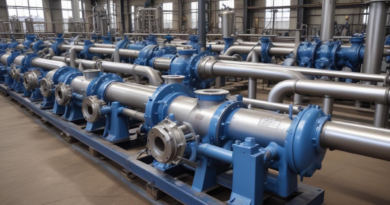pumps used in the dairy industry
Dairy pumps are essential components in various stages of dairy processing, each type tailored to specific applications to ensure efficiency and maintain product integrity. The primary types of pumps used in the dairy industry include:
- Centrifugal Pumps: Utilized for their ability to handle large volumes of liquid with minimal maintenance. They are ideal for transferring milk and other fluids within processing plants due to their continuous flow and reliability.
- Positive Displacement Pumps: These pumps are preferred when precise flow control is necessary. They are commonly used in applications such as dosing additives and handling viscous dairy products like cream and yogurt.
- Peristaltic Pumps: Known for their hygienic operation, peristaltic pumps are suitable for transferring sterile liquids. They minimize contamination risks, making them perfect for filling and packaging operations.
- Screw Pumps: Employed for their capability to move thick and shear-sensitive products without degrading the product quality. They are effective in handling products like cheese and other semi-solid dairy items.
- Gear Pumps: Often used in lubrication systems for machinery within dairy plants, ensuring smooth operation and longevity of equipment.
| Type of Pump | Key Applications | Advantages |
|---|---|---|
| Centrifugal Pumps | Milk transfer, fluid transport | High flow rates, low maintenance |
| Positive Displacement Pumps | Dosing additives, handling viscous products | Precise flow control, consistent performance |
| Peristaltic Pumps | Sterile liquid transfer, packaging | Hygienic, minimal contamination |
| Screw Pumps | Handling semi-solid dairy products | Gentle handling, reduces product degradation |
| Gear Pumps | Lubrication systems | Reliable operation, equipment protection |
Each pump type offers unique benefits tailored to specific applications within the dairy sector, ensuring that operations run smoothly while maintaining the highest standards of product quality and safety.
selection criteria for dairy pumps
Selecting the appropriate dairy pumps is crucial to ensure seamless operations, maintain product quality, and comply with stringent food safety standards. The following criteria are essential in the selection process:
- Material Construction: Pumps must be made from materials that are resistant to corrosion and suitable for food contact. Typically, stainless steel is preferred due to its durability, ease of cleaning, and compliance with sanitary standards.
- Hygienic Design: The design should facilitate easy cleaning and prevent contamination. Features such as smooth surfaces, minimal crevices, and accessible components are important to maintain hygiene.
- Flow Rate and Capacity: The pump must handle the required flow rates and volumes specific to the dairy application, whether it’s transferring milk, pumping cream, or dispensing yogurt.
- Viscosity and Temperature Handling: Different dairy products have varying viscosities and are processed at specific temperatures. The selected pump should efficiently handle these variations without compromising product integrity.
- Energy Efficiency: Energy-efficient pumps reduce operational costs and support sustainable practices within the dairy facility.
- Maintenance and Reliability: Pumps should require minimal maintenance, have readily available spare parts, and demonstrate high reliability to minimize downtime and ensure continuous production.
- Compliance with Regulations: Adherence to food safety standards such as FDA or NSF certifications is essential to ensure the pump meets industry regulations and maintains product safety.
- Compatibility with Existing Systems: The pump should integrate seamlessly with the existing infrastructure and other equipment in the dairy processing line, ensuring smooth operation and efficiency.
To systematically compare how different types of pumps meet these selection criteria, consider the following table:
| Selection Criterion | Centrifugal Pumps | Positive Displacement Pumps | Peristaltic Pumps | Screw Pumps |
|---|---|---|---|---|
| Material Construction | Stainless steel widely used | Stainless steel, hygienic materials | Food-grade tubing and components | Stainless steel, compatible with dairy products |
| Hygienic Design | Designed for easy cleaning | Sanitary design, easy to disassemble | Minimal contamination risk, easy sterilization | Gentle handling reduces contamination risk |
| Flow Rate | High flow rates suitable for bulk transfer | Precise flow control for dosing | Consistent flow for sterile applications | Moderate flow suitable for semi-solids |
| Viscosity Handling | Limited handling of high-viscosity products | Excellent for viscous products | Ideal for low to medium viscosity liquids | Effective for varied viscosities |
| Energy Efficiency | Generally energy efficient for large volumes | Energy usage varies with precision needs | Moderate energy consumption | Energy efficient for specific applications |
| Maintenance | Low maintenance requirements | Requires regular inspection for wear | Minimal maintenance due to simple mechanics | Requires periodic maintenance to ensure performance |
By meticulously evaluating these criteria, dairy processors can make informed decisions when selecting pumps that not only meet their operational requirements but also uphold the highest standards of product quality and safety.
maintenance and cleaning practices
Proper upkeep and sanitation are critical to ensure the longevity and optimal performance of dairy pumps. Implementing comprehensive maintenance and cleaning protocols not only extends the lifespan of the equipment but also safeguards product quality and complies with stringent food safety standards.
Regular Maintenance Procedures are essential for preventing unexpected downtimes and minimizing wear and tear. Key practices include:
- Scheduled Inspections: Conduct routine checks to identify signs of wear, corrosion, or damage. Inspect seals, bearings, and moving parts to ensure they are functioning correctly.
- Lubrication: Apply appropriate lubricants to moving components as per manufacturer recommendations to reduce friction and prevent premature failure.
- Component Replacement: Replace worn or damaged parts promptly to maintain pump efficiency and prevent contamination risks.
- Performance Monitoring: Continuously monitor pump performance metrics such as flow rate, pressure, and vibration to detect anomalies early.
Cleaning Practices are paramount in the dairy industry to prevent microbial contamination and ensure product safety. Effective cleaning involves:
- CIP (Clean-In-Place) Systems: Utilize automated CIP systems to clean internal surfaces without disassembling the pump. CIP cycles typically include rinsing, cleaning with alkaline or acidic solutions, and sanitizing.
- Disassembly and Manual Cleaning: For thorough sanitation, periodically disassemble pump components to clean hard-to-reach areas. Use food-grade cleaning agents to eliminate residues and contaminants.
- Hygienic Design Features: Ensure that pumps have smooth surfaces, minimal crevices, and accessible parts to facilitate easy cleaning and reduce contamination risks.
- Verification and Validation: Implement validation procedures to confirm the effectiveness of cleaning processes, including microbiological testing and visual inspections.
Adhering to a structured maintenance and cleaning schedule can be organized as follows:
| Maintenance Task | Frequency | Applicable Pump Types | Notes |
|---|---|---|---|
| Visual Inspection for Leaks and Damage | Daily | All types | Early detection of issues prevents major failures |
| Lubricate Moving Parts | Weekly | Centrifugal, Positive Displacement, Screw Pumps | Use recommended lubricants to ensure compatibility |
| Clean Internal Components | After each production run | Peristaltic, Positive Displacement, Screw Pumps | Utilize CIP protocols to maintain hygiene |
| Replace Seals and O-Rings | Monthly or as needed | All types | Prevent leaks and maintain sanitary conditions |
| Performance Testing | Quarterly | All types | Ensure pumps operate within specified parameters |
| Deep Cleaning and Disassembly | Biannually | All types | Thorough sanitation to eliminate stubborn residues |
Documentation and Training are also vital components of an effective maintenance and cleaning strategy. Maintaining detailed records of all maintenance activities ensures traceability and adherence to regulatory requirements. Additionally, training staff on proper maintenance techniques and hygiene practices fosters a culture of accountability and continuous improvement.
Implementing these maintenance and cleaning practices guarantees that dairy pumps operate efficiently, produce high-quality products, and comply with industry standards. By prioritizing these protocols, dairy facilities can achieve operational excellence and uphold the integrity of their processing systems.
applications in dairy processing
 Dairy processing encompasses a wide range of operations where different types of pumps play pivotal roles in ensuring efficiency, product quality, and safety. Each stage of the dairy production line leverages specific pump types tailored to meet the unique demands of the process. Below are the primary applications of dairy pumps across various processing stages:
Dairy processing encompasses a wide range of operations where different types of pumps play pivotal roles in ensuring efficiency, product quality, and safety. Each stage of the dairy production line leverages specific pump types tailored to meet the unique demands of the process. Below are the primary applications of dairy pumps across various processing stages:
- Milk Reception and Storage: Upon arrival at the processing facility, raw milk is transferred from storage tanks to processing units. Centrifugal pumps are commonly used in this stage due to their ability to handle large volumes with consistent flow rates, ensuring smooth transportation of milk from collection points to storage silos.
- Pasteurization: The pasteurization process requires precise temperature control and flow rates to effectively eliminate harmful microorganisms. Positive displacement pumps are ideal for this application, providing accurate control over the flow and maintaining consistent pressure, which is crucial for achieving the desired pasteurization conditions.
- Homogenization: To ensure uniform fat distribution and prevent cream separation, milk undergoes homogenization. Gear pumps are often employed in this stage to maintain a steady flow and pressure, facilitating the effective breakdown of fat globules and ensuring a smooth, homogenous product.
- Fermentation: In the production of yogurt and other fermented dairy products, maintaining a sterile environment is essential. Peristaltic pumps are preferred for transferring cultures and additives during fermentation due to their hygienic operation and minimal risk of contamination.
- Cheese Production: The handling of semi-solid and viscous dairy products like cheese requires pumps that can manage thick textures without degrading the product quality. Screw pumps are well-suited for this application, offering gentle handling and effective movement of curds and other semi-solid materials.
- Packaging and Filling: Automated filling and packaging lines rely on precise and reliable pumping systems to ensure accurate dosing and minimal product loss. Peristaltic pumps are frequently used in these applications due to their ability to deliver consistent flow rates and their ease of integration into automated systems.
- Cleaning-In-Place (CIP) Systems: Maintaining hygiene standards is critical in dairy processing. Centrifugal pumps and peristaltic pumps are integral to CIP systems, facilitating the circulation of cleaning and sanitizing solutions through processing equipment without the need for disassembly.
- Lubrication Systems: To ensure the longevity and optimal performance of machinery within dairy plants, proper lubrication is essential. Gear pumps are typically used in lubrication systems to provide a steady supply of lubricants to various components, reducing friction and preventing mechanical failures.
| Processing Stage | Type of Pump | Function |
|---|---|---|
| Milk Reception and Storage | Centrifugal Pumps | Transfer large volumes of raw milk efficiently |
| Pasteurization | Positive Displacement Pumps | Maintain precise flow rates and temperatures |
| Homogenization | Gear Pumps | Ensure uniform fat distribution |
| Fermentation | Peristaltic Pumps | Transfer cultures and additives hygienically |
| Cheese Production | Screw Pumps | Handle semi-solid curds without degradation |
| Packaging and Filling | Peristaltic Pumps | Provide accurate dosing for packaging |
| Cleaning-In-Place (CIP) Systems | Centrifugal & Peristaltic Pumps | Circulate cleaning and sanitizing solutions |
| Lubrication Systems | Gear Pumps | Supply lubricants to machinery components |
The strategic application of different types of dairy pumps across these processing stages not only enhances operational efficiency but also ensures that the final dairy products meet the highest standards of quality and safety. By leveraging the unique capabilities of each pump type, dairy processors can optimize their workflows, reduce downtime, and maintain product integrity throughout the production cycle.
future trends and innovations
Advancements in technology and evolving industry demands are driving significant innovations in the realm of dairy pumps. These future-oriented developments focus on enhancing efficiency, sustainability, and integration within dairy processing systems.
Smart Pump Technologies are becoming increasingly prevalent, incorporating sensors and automation to monitor and control pump performance in real-time. These intelligent systems can adjust flow rates and pressures automatically based on processing requirements, leading to optimized operations and reduced energy consumption. Key features include:
- Real-Time Monitoring: Utilizing sensors to track parameters such as flow rate, temperature, and pressure, enabling immediate adjustments and early detection of potential issues.
- Predictive Maintenance: Leveraging data analytics and machine learning algorithms to predict maintenance needs before failures occur, thereby minimizing downtime and maintenance costs.
- Remote Accessibility: Allowing operators to control and monitor pumps remotely through cloud-based platforms, enhancing flexibility and responsiveness in managing dairy operations.
Energy Efficiency Improvements are a critical focus area, given the high energy demands of dairy processing facilities. Innovations aim to reduce energy consumption without compromising pump performance. Strategies include:
- Advanced Motor Designs: Implementing high-efficiency motors that consume less power while delivering the same or enhanced performance levels.
- Variable Frequency Drives (VFDs): Integrating VFDs to adjust motor speed based on demand, thereby optimizing energy usage and reducing operational costs.
- Optimized Hydraulic Systems: Designing pump systems with improved hydraulics to minimize energy losses and enhance overall efficiency.
Sustainable Materials and Construction are gaining traction as the dairy industry places greater emphasis on environmental responsibility. Future innovations focus on:
- Eco-Friendly Materials: Utilizing materials that are not only durable and corrosion-resistant but also have a lower environmental impact, such as recyclable stainless steel alloys and biodegradable components.
- Modular Designs: Creating pump systems with modular components that can be easily upgraded or replaced, extending the lifespan of the equipment and reducing waste.
- Reduced Carbon Footprint Manufacturing: Adopting manufacturing processes that lower carbon emissions and energy usage during the production of dairy pumps.
Integration with IoT and Industry 4.0 is revolutionizing how dairy pumps interact within the broader processing ecosystem. Enhanced connectivity allows for seamless integration with other machinery and supervisory control systems, facilitating:
- Data Sharing and Analytics: Enabling comprehensive data collection and analysis to improve decision-making and optimize processing workflows.
- Automated Process Control: Synchronizing pump operations with other processing units for streamlined and efficient production lines.
- Enhanced Traceability: Providing detailed logs of pump performance and maintenance activities, contributing to better quality control and regulatory compliance.
Enhanced Hygiene and Sanitation Features continue to evolve, addressing the stringent cleanliness standards of the dairy industry. Innovations include:
- Self-Cleaning Mechanisms: Pumps equipped with self-cleaning capabilities that reduce the need for manual cleaning and minimize contamination risks.
- Antimicrobial Coatings: Applying coatings that inhibit microbial growth on pump surfaces, enhancing overall sanitary conditions.
- Improved Sealing Technologies: Developing seals that are more resistant to wear and easier to sanitize, ensuring consistent hygiene standards.
Advanced Control Systems are being developed to provide greater precision and flexibility in pump operations. These systems offer:
- Enhanced Precision: Delivering more accurate flow and pressure control, crucial for delicate dairy applications such as fermentation and homogenization.
- User-Friendly Interfaces: Implementing intuitive interfaces that simplify pump management and allow for easier configuration and adjustments by operators.
- Automated Calibration: Facilitating automatic calibration processes to maintain optimal pump performance with minimal manual intervention.
The integration of these future trends and innovations into dairy pumps will not only enhance operational efficiency and product quality but also support the industry’s move towards more sustainable and technologically advanced processing methods. By embracing these advancements, dairy processors can achieve greater resilience, adaptability, and competitiveness in a rapidly evolving market.
| Future Innovation | Description | Benefits |
|---|---|---|
| Smart Pump Technologies | Incorporation of sensors and automation for real-time monitoring and control | Optimized operations, reduced energy consumption, predictive maintenance |
| Energy Efficiency Improvements | Use of advanced motor designs, VFDs, and optimized hydraulics | Lower energy costs, enhanced performance, reduced environmental impact |
| Sustainable Materials and Construction | Use of eco-friendly materials and modular designs | Extended equipment lifespan, lower environmental footprint, reduced waste |
| Integration with IoT and Industry 4.0 | Seamless connectivity with other machinery and data analytics platforms | Improved decision-making, automated process control, enhanced traceability |
| Enhanced Hygiene and Sanitation Features | Development of self-cleaning mechanisms and antimicrobial coatings | Minimized contamination risks, easier maintenance, consistent hygiene standards |
| Advanced Control Systems | Precision flow control and user-friendly interfaces | Greater operational precision, simplified pump management, automated calibration |
These forward-thinking developments are set to transform the landscape of dairy pumps, ensuring that the industry continues to meet the growing demands for efficiency, quality, and sustainability.




